Optimization of Algorithm for Solving Railroad Power Conditioner Compensation Power Reference Value and System Power Quality Analysis Based on Optimal Compensation Model
Abstract
:1. Introduction
2. System Structure and Energy Flow Patterns
2.1. System Topology
2.2. Control System Structure
2.3. System Energy Flow Patterns
3. Optimized Compensation Model
3.1. Optimizing the Objective Function
3.2. Constraint Condition
3.3. Relationship between Power Quality Parameters and Converter Compensation Power
4. Compensated Power Reference PSO Algorithm Improvement
- (1)
- Import of real-time data from the traction/photovoltaic side: voltage and current are detected in real-time by the -phase/-phase power supply arms (, , , ), active and reactive power is output from the two power supply arms (, , , ), compensated power from the two-phase converter (, , , ) is detected in real-time, active power is output from the photovoltaic unit to the two-phase converter , and the corresponding power reference value is obtained from the energy management unit.
- (2)
- Initializing the particle population: set the population size m and iteration number n, create an array of particle structures, randomly initialize the particle position x, randomly initialize the particle velocity v, initialize the individual particle optimal solution position pbest to infinity, and initialize the individual particle optimal position to its initial position. Initialize the group optimal position gbest.
- (3)
- Entering the PSO main loop introduces dynamically adjusted inertia weights A, dynamically adjusted self-awareness factors B, and social factors C. The formulas introduced are as follows:Dynamic weighting is 0.9~0.4Self-awareness factor is 2~2.5Social factor is 2~2.5.
- (4)
- Calculate particle fitness f according to the objective function in Section 3.1.
- (5)
- Update the current optimal position of the particle and the optimal position of the group according to the fitness. If the value of the current position function is less than the individual optimal position, then update the individual optimal position; if the value of the current position function is less than the global optimal, then update the global optimal position.
- (6)
- Update the velocity and position of the particles in conjunction with the particle iteration formula according to the constraints given in Section 3.2. The particle iteration formula is as follows:where is the dth dimensional component of the flight velocity vector of particle i in the kth iteration; is the dth dimensional component of the position vector of particle i in the kth iteration; and are the individual and population learning factors, respectively; and are independent random numbers with values in the range [0, 1]; and is the inertia weight.
- (7)
- When the maximum number of iterations is reached, the improved particle swarm algorithm iteration is exited. At this point, the optimal compensation power reference is converted to a current reference.
5. Simulation Results
5.1. Active Compensation Energy Simulation
- (1)
- ① Both arms are in a traction state. The -phase traction load power is set to and the -phase traction load power is set to . The simulation results are shown in Figure 3a. The -phase converter is able to effectively track the load variations of both arms, i.e., it actively distributes more PV power to the -phase arm with a larger load, and after the stabilization of and in the figure, the unutilized PV power, , basically satisfies the energy transfer relationship (the power difference is due to the system losses and the measurement error). ② Single-arm-braking single-arm traction and the overall traction state. and are set. The simulation results are shown in Figure 3b. The -phase braking power priority from the -phase converter transfer is (in this case, all -phase braking power is transferred, and excess energy is transferred from the grid to supplement) because the transfer of braking energy is still not enough to supply energy for the -phase traction loads, and the insufficient part of the photovoltaic power generation unit with the supply in this case ()—that is, the photovoltaic unit to provide a 0.51 MW of electricity, and —basically meets the energy transfer relationship. ③ Single-arm-braking single-arm traction and the overall braking dynamic. and are set. The simulation results are shown in Figure 3c. The -phase braking power is transferred from the -phase converter to . The PV power unit no longer transmits power to the outside world, i.e., (the power difference is caused by the system loss and the measurement error) and . ④ Both arms are in braking mode. and are set. The simulation results are shown in Figure 3d. The photovoltaic unit no longer delivers power to the traction load, and only the -phase braking power is transferred through the back-to-back converter to reduce the asymmetry of the two arms, i.e., and .
- (2)
- ① Both arms are in the traction state, and the simulation results are shown in Figure 4a. The back-to-back converter starts to merge into the traction network at 0.2 s. and , i.e., part of the active power is transferred from the -phase traction feeder to the -phase through the back-to-back converter. ② Single-arm-braking single-arm traction and the overall traction state. The simulation results are shown in Figure 4b. and , that is, on the basis of the -phase, all braking energy is transferred to the -phase feeder in order to improve the inter-phase load imbalance, and part of the active power from the -phase feeder is then transferred to the -phase. ③ Single-arm-braking single-arm traction. The whole arm is in braking mode. The simulation results are shown in Figure 4c. and , i.e., the braking energy of phase is partially transferred to phase . ④ Both arms have braking dynamics and the simulation results are shown in Figure 4d. Only the -phase braking power is transferred through the back-to-back converter for energy transfer to minimize the asymmetry of loads in both arms, i.e., and .
- (3)
- The improved PSO algorithm for solving the reference value of compensated power converges better. This enables the RPC to obtain a more accurate and stable power reference value during the control process, which in turn enables the system to operate stably, and can effectively realize the dynamic distribution between PV power, traction load power, and unused power.
5.2. Reactive Compensation Energy Simulation
- (1)
- Corresponds to Section 5.1 in the case of PV output. Case 1: Two-phase converter with some reactive power compensation. and . ② Condition 2: Phase load is in the braking state, which is equivalent to emitting reactive power. In this case, the phase converter absorbs reactive power , realizing the function of reactive power compensation. In this case, . ③ Condition 3: and . Negative values are analyzed as in Condition 2. ④ Condition 4: and .
- (2)
- In the case of no PV output, Case 1: and . Case 2: and . Case 3: and . Case 4: and . Meanwhile, the improved PSO algorithm results in better convergence of the solution.
5.3. Power Factor and Negative Sequence Current Change Simulation
6. Conclusions
- Idea: In order to realize access to the traction power supply system of the photovoltaic unit near the consumption, take into account the power quality improvement effect of the traction power supply system as well as train regenerative braking energy recycling in real time. This paper designs a traction photovoltaic power generation system in the railroad power regulator as a breakthrough. The railroad power regulator through the system energy control module is calculated using the reference value to act as a coordinated distributed power supply and traction system energy transfer capacity, in order to improve the convergence of the system’s compensation power reference value more. This paper begins to optimize the RPC compensation model and PSO algorithm given in the original literature, so that, through a more accurate reference value, the braking energy is better recycled using photovoltaic power, in addition to the compensation model achieving a certain degree of power quality improvement effect.
- The chapters of this paper contain the following: abstract; 1. introduction; 2. topology, control structure, and energy flow mode of PV power generation system for traction; 3. the optimized railroad power regulator compensation model; 4. the improvement in the PSO algorithm; 5. simulation results; and 6. conclusions. Since the energy management strategy is specified in the literature [13], energy management is not included as a section in the article. I go over the strategy in a brief and concise manner in Section 2 (the added parts are marked in yellow).
- Compared with the previous literature, this paper optimizes the compensation model and improves the PSO algorithm to improve the convergence of the power reference. In this way, the railroad power regulator can realize the energy flow, regenerative braking energy transfer between phases, and PV power dissipation more accurately in real time according to the reference value. It also improves the negative sequence current and power factor.
Author Contributions
Funding
Conflicts of Interest
References
- Wu, X.; Li, Y.; Liu, J. Comparative analysis of railway energy consumption between China and other countries. Sci. Technol. Rev. 2016, 34, 313–317. [Google Scholar]
- Ren, J.; Zhang, Q.; Liu, F. Analysis of factors affecting traction energy consumption of electric multiple unit trains based on data mining. J. Clean. Prod. 2020, 262, 121374. [Google Scholar] [CrossRef]
- Zhang, H.; Jia, L.; Wang, L.; Xu, X. Energy consumption optimization of train operation for railway systems: Algorithm development and real-world case study. J. Clean. Prod. 2019, 214, 1024–1037. [Google Scholar] [CrossRef]
- Chen, W.; Wang, X.; Li, Q.; Han, Y.; Wang, W. Review on the development status of PV power station accessing to traction power supply system for rail transit. Power Syst. Technol. 2019, 43, 3663–3670. (In Chinese) [Google Scholar]
- Dent, C.M. China’s renewable energy development: Policy, industry and business perspectives. Asia Pac. Bus. Rev. 2015, 21, 26–43. [Google Scholar] [CrossRef]
- Chen, J.; Zhao, Y.; Wang, M.; Wang, K.; Huang, Y.; Xu, Z. Power Sharing and Storage-Based Regenerative Braking Energy Utilization for Sectioning Post in Electrified Railways. IEEE Trans. Transp. Electrif. 2023. [Google Scholar] [CrossRef]
- Wu, M.; Wang, W.; Deng, W.; Chen, H.; Dai, C.; Chen, W. Back-to-back PV generation system for electrified railway and its control strategy. In Proceedings of the 2017 IEEE Transportation Electrification Conference and Expo, Asia-Pacific (ITEC Asia-Pacific), Harbin, China, 7–10 August 2017; pp. 1–6. [Google Scholar]
- Shu, Z.; Xie, S.; Li, Q. Single-phase back-to-back converter for active power balancing, reactive power compensation, and harmonic filtering in traction power system. IEEE Trans. Power Electron. 2010, 26, 334–343. [Google Scholar] [CrossRef]
- Ma, F.; Luo, A.; Xu, X.; Xiao, H.; Wu, C.; Wang, W. A simplified power conditioner based on half-bridge converter for high-speed railway system. IEEE Trans. Ind. Electron. 2013, 60, 728–738. [Google Scholar] [CrossRef]
- Babu, A.; Sreejaya, P. Reduced rating railway power conditioners in co-phase traction and traditional traction system. In Proceedings of the 2015 International Conference on Control Communication & Computing India, Trivandrum, India, 19–21 November 2015; pp. 291–296. [Google Scholar]
- Perin, I.; Nussey, P.F.; Cella, U.M.; Tran, T.V.; Walker, G.R. Application of power electronics in improving power quality and supply efficiency of AC traction networks. In Proceedings of the 2015 IEEE 11th International Conference on Power Electronics and Drive Systems, Sydney, NSW, Australia, 9–12 June 2015; pp. 1086–1094. [Google Scholar]
- Wu, M.; Dai, C.; Deng, W.L.; Gao, Y.; Chen, H.B.; Chen, W. Back-to-back PV generation system and its control strategy for electrified railway. Power Syst. Technol. 2018, 2, 541–547. [Google Scholar]
- Wu, M.; Gao, Y.; Deng, W.; Dai, C.; Chen, W. Study of PV generation application on AC powered traction system. In Proceedings of the 2017 Chinese Automation Congress (CAC), Jinan, China, 20–22 October 2017; pp. 1641–1646. [Google Scholar]
- Deng, W.; Dai, C.; Guo, A.; Shi, F.; Han, C.; Wu, M.; Xue, C. Harmonic interaction influence of PV generation system accessing to traction power supply system and its adaptability analysis. Electr. Power Autom. Equip. 2019, 39, 181–189. [Google Scholar]
- Deng, W.; Dai, C.; Zhang, H.; Zhang, L.; Li, M.; Wu, Z. Research on comprehensive optimization control method for traction photovoltaic generation system of complex electrified railway. Proc. CSEE 2020, 40, 5849–5865. (In Chinese) [Google Scholar]
- Roudsari, H.M.; Jalilian, A.; Jamali, S. Flexible fractional compensating mode for railway static power conditioner in a V/v traction power supply system. IEEE Trans. Ind. Electron. 2018, 65, 7963–7974. [Google Scholar] [CrossRef]
- Luo, P.; Huang, Q.; Li, S.; Chen, Y.; Zhou, G.; Luo, L.; Zhang, Z. Negative Sequence Current and Reactive Power Comprehensive Optimizing Control of V/v Connected Traction Substations. IEEE Trans. Power Electron. 2017, 31, 200–212. [Google Scholar]
- Ma, Q.; Tan, L.; Luo, P. Optimal negative-sequence compensation of hybrid power-quality management system for v/v traction substation. Electr. Power Autom. Equip. 2017, 37, 128–132. [Google Scholar]
- Zhang, D.; Zhang, Z.; Wang, W.; Yang, Y. Negative sequence current optimizing control based on railway static power conditioner in V/v traction power supply system. IEEE Trans. Power Electron. 2016, 31, 200–212. [Google Scholar] [CrossRef]
- Cao, Y.; Ma, L.; Zhang, Y. Application of fuzzy predictive control technology in automatic train operation. Clust. Comput. 2019, 22, 14135–14144. [Google Scholar] [CrossRef]
- Chellaswamy, C.; Krishnasamy, M.; Balaji, L.; Dhanalakshmi, A.; Ramesh, R. Optimized railway track health monitoring system based on dynamic differential evolution algorithm. Measurement 2020, 152, 107332. [Google Scholar] [CrossRef]
- Jiang, Y.; Wang, W.; Jiang, X.; Zhao, L.; Cao, Y. Capacity optimization of railway static power conditioner based on particle swarm optimization. Power Electron. 2019, 53, 31–33. (In Chinese) [Google Scholar]
- Deng, W.; Dai, C.; Chen, W.; Zhang, H. Research progress of railway power conditioner. CSEE 2020, 40, 4640–4655. (In Chinese) [Google Scholar]

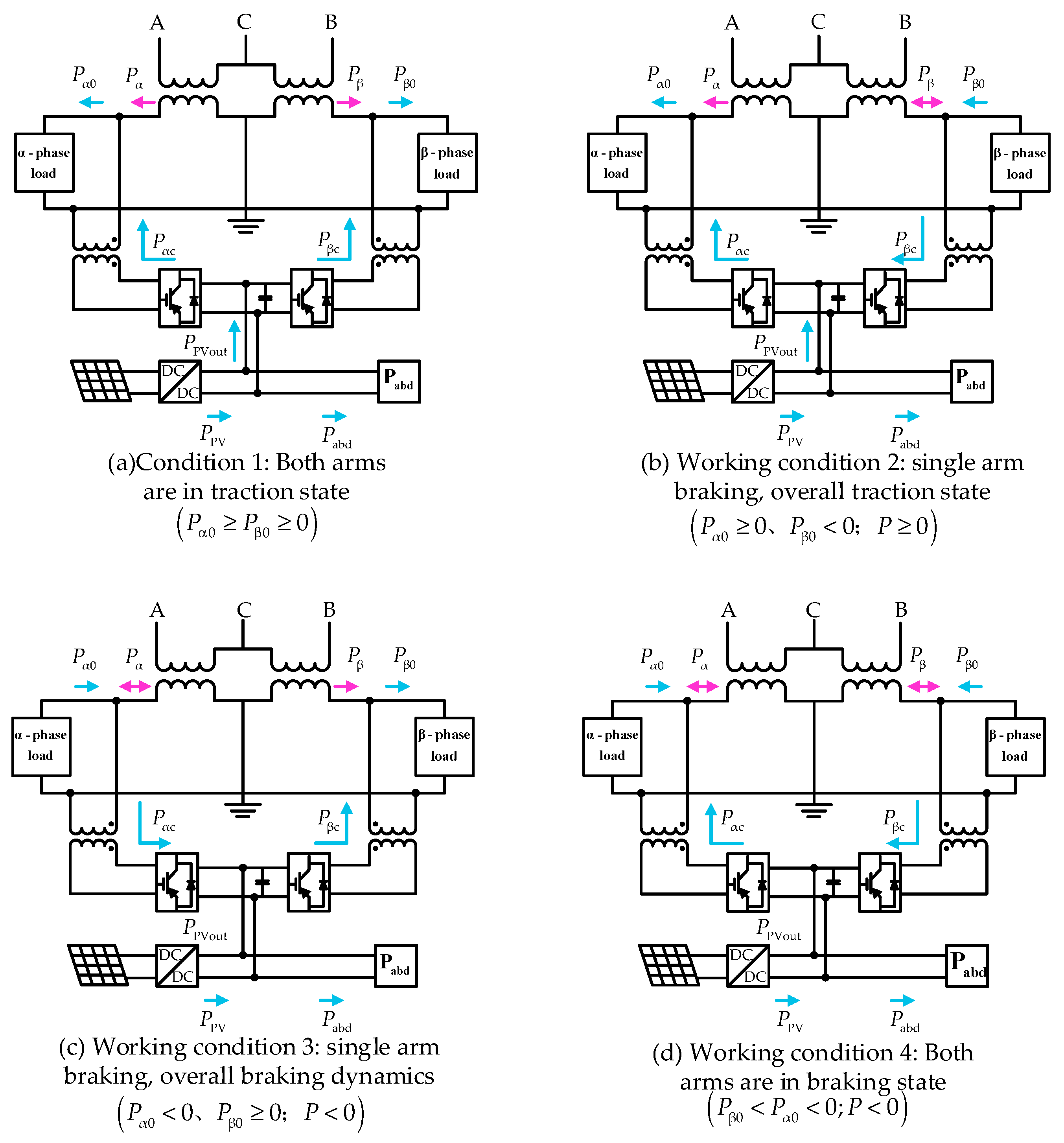

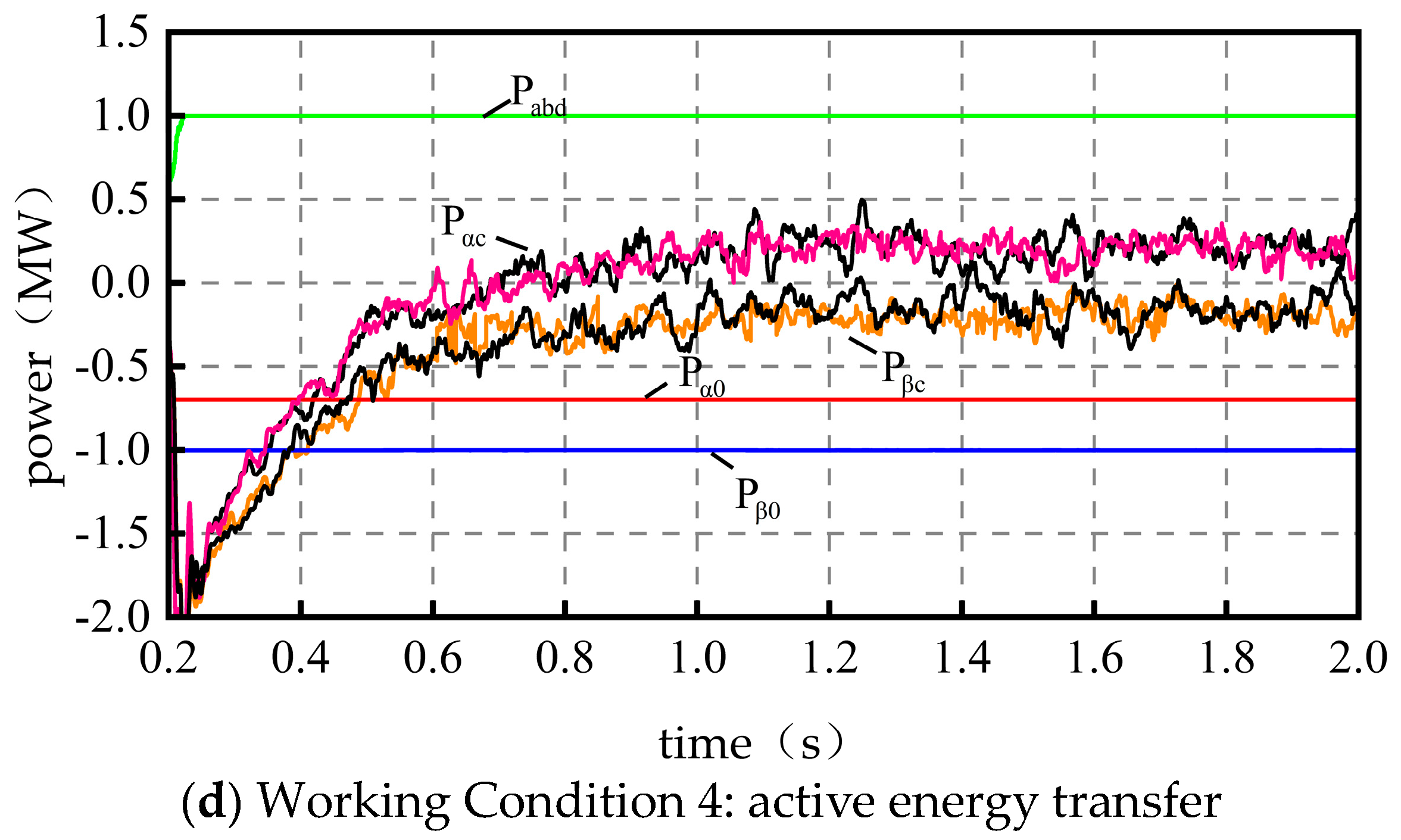


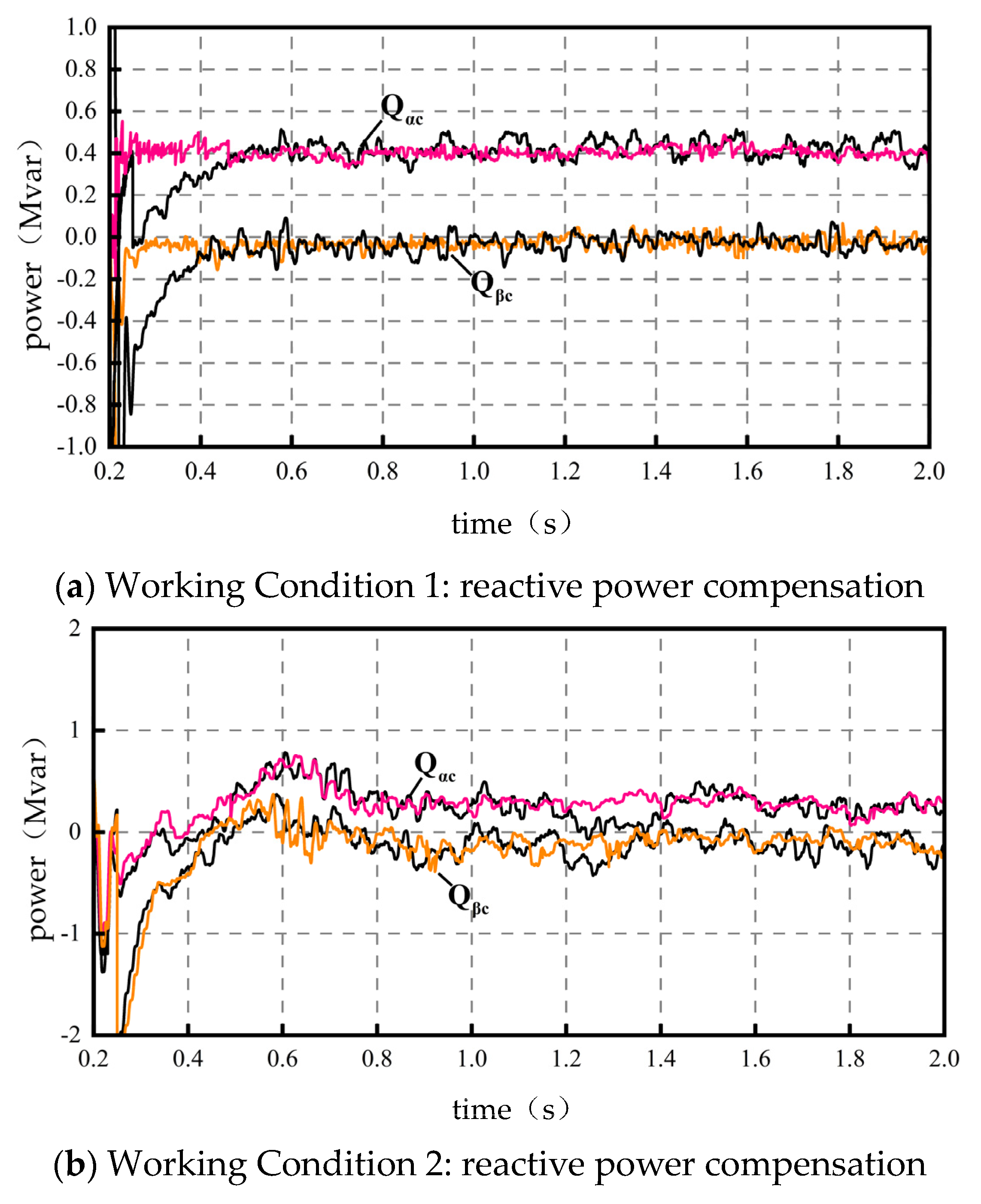

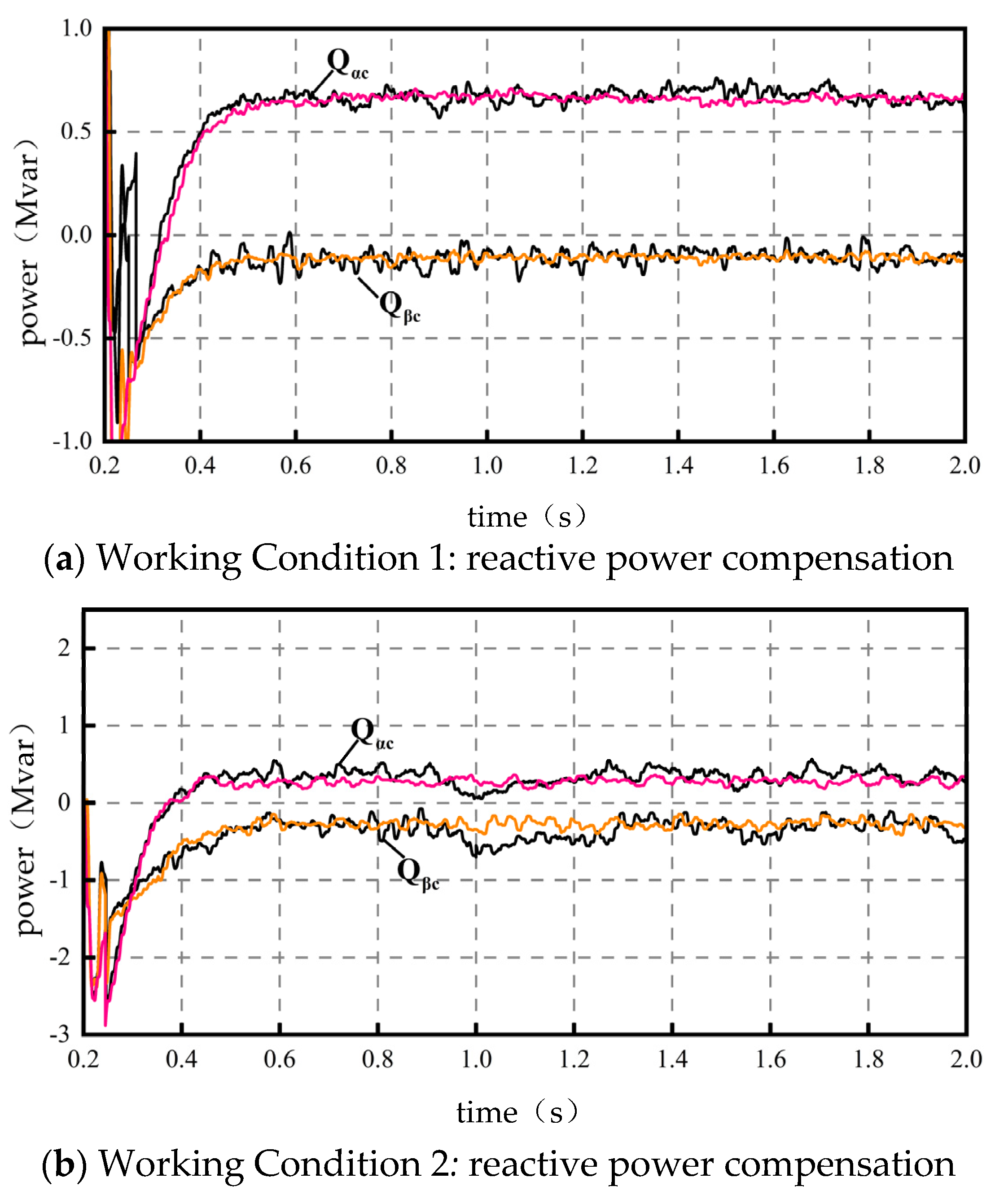
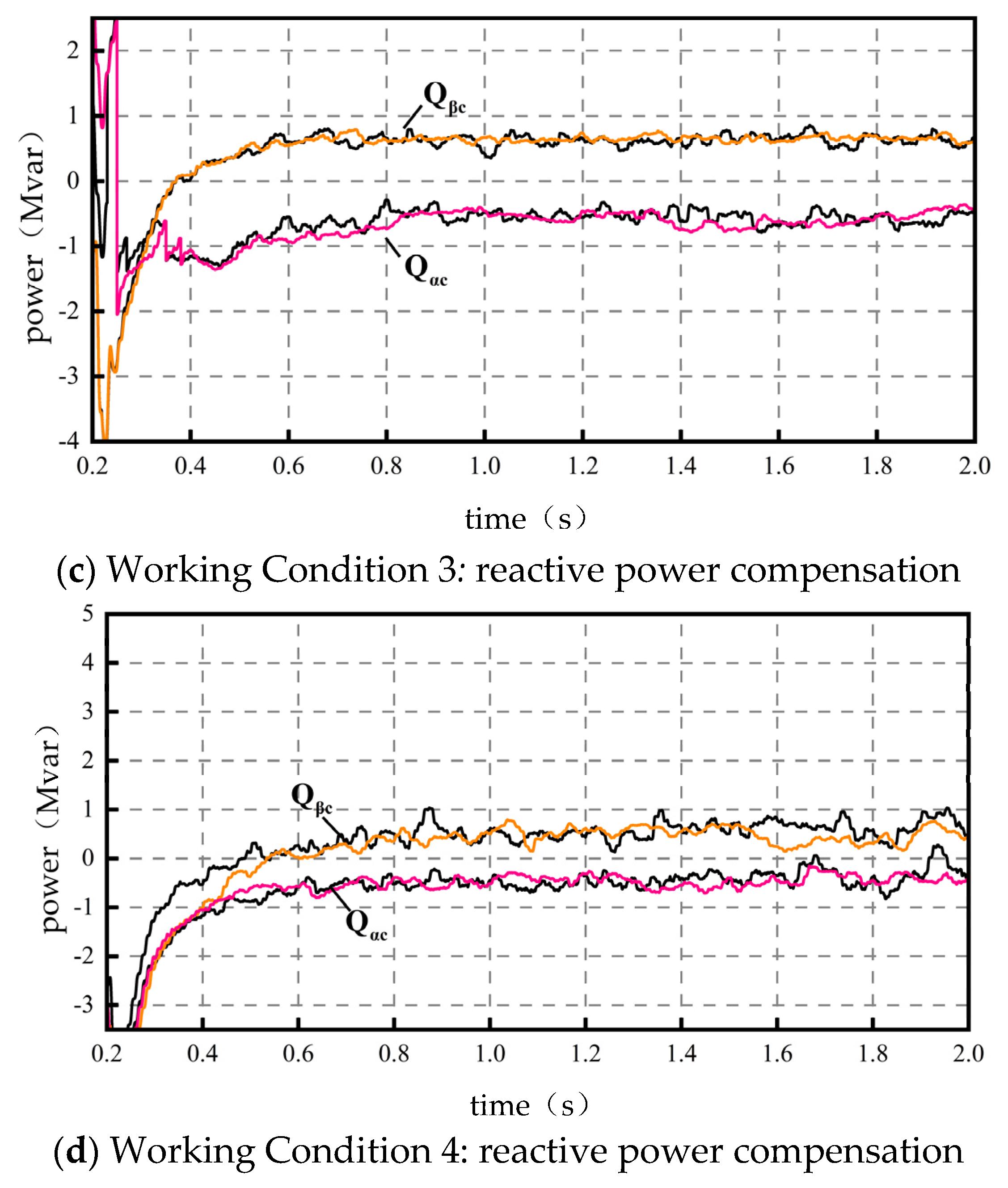
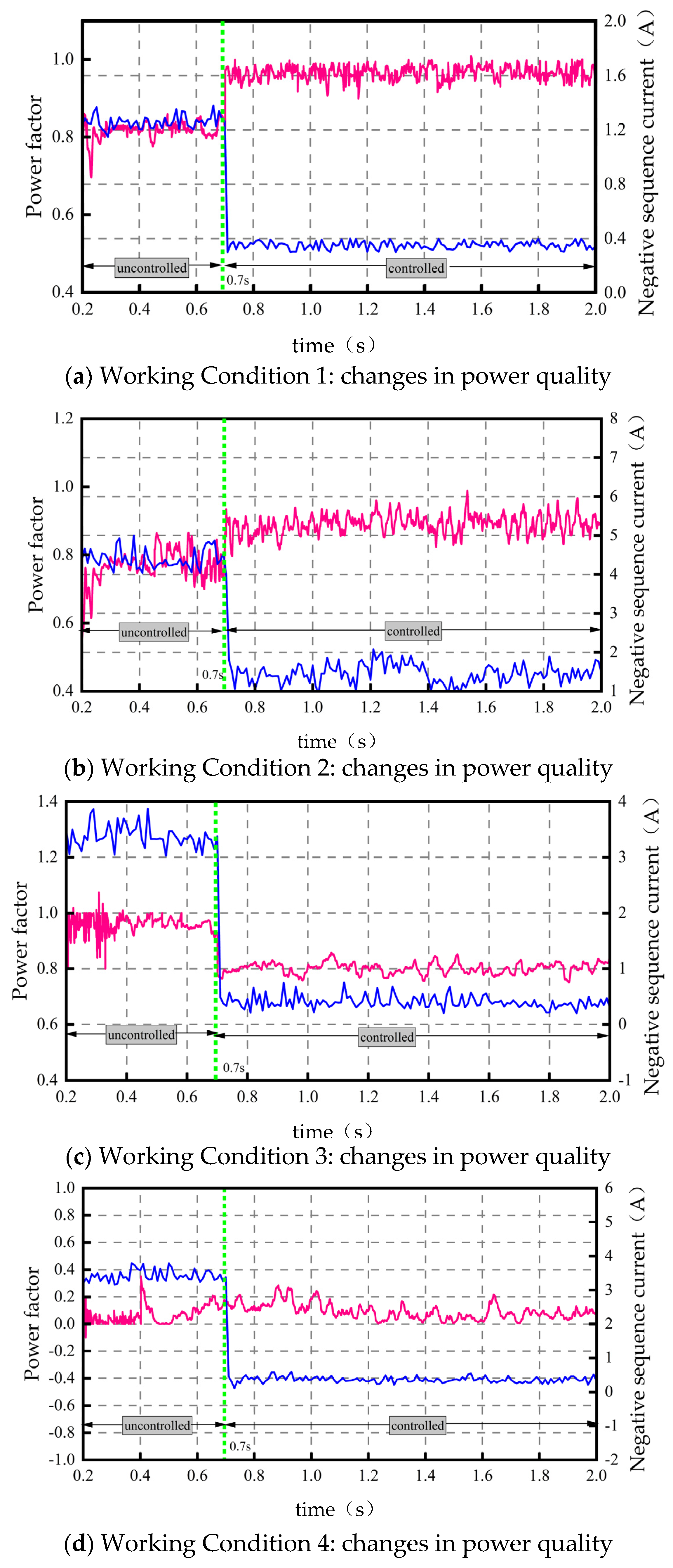

| 220/27.5 | ||
| 27.5/1 | ||
| 2000 | ||
| 0.98 |
| Operating Conditions (PV) | Uncontrolled | Controlled | Incremental |
|---|---|---|---|
| 1 | 0.82 | 0.94 | 0.12 |
| 2 | 0.79 | 0.90 | 0.11 |
| 3 | 0.96 | 0.81 | −0.15 |
| 4 | 0 | 0 | 0 |
| Operating Conditions (No PV) | Uncontrolled | Controlled | Incremental |
|---|---|---|---|
| 1 | 0.83 | 0.92 | 0.09 |
| 2 | 0.84 | 0.95 | 0.11 |
| 3 | 0.94 | 0.80 | −0.14 |
| 4 | 0 | 0 | 0 |
| Operating Conditions (PV) | Uncontrolled | Controlled | Incremental |
|---|---|---|---|
| 1 | 1.30 A | 0.39 A | −0.91 A |
| 2 | 4.30 A | 1.40 A | −2.90 A |
| 3 | 3.20 A | 0.40 A | −2.80 A |
| 4 | 3.40 A | 0.50 A | −2.90 A |
| Operating Conditions (No PV) | Uncontrolled | Controlled | Incremental |
|---|---|---|---|
| 1 | 2.60 A | 0.40 A | −2.20 A |
| 2 | 4.20 A | 1.10 A | −3.10 A |
| 3 | 8.70 A | 3.10 A | −5.60 A |
| 4 | 2.20 A | 0.50 A | −1.70 A |
Disclaimer/Publisher’s Note: The statements, opinions and data contained in all publications are solely those of the individual author(s) and contributor(s) and not of MDPI and/or the editor(s). MDPI and/or the editor(s) disclaim responsibility for any injury to people or property resulting from any ideas, methods, instructions or products referred to in the content. |
© 2023 by the authors. Licensee MDPI, Basel, Switzerland. This article is an open access article distributed under the terms and conditions of the Creative Commons Attribution (CC BY) license (https://creativecommons.org/licenses/by/4.0/).
Share and Cite
Ding, C.; Guo, Y.; You, H.; Zhang, H. Optimization of Algorithm for Solving Railroad Power Conditioner Compensation Power Reference Value and System Power Quality Analysis Based on Optimal Compensation Model. Energies 2023, 16, 7073. https://doi.org/10.3390/en16207073
Ding C, Guo Y, You H, Zhang H. Optimization of Algorithm for Solving Railroad Power Conditioner Compensation Power Reference Value and System Power Quality Analysis Based on Optimal Compensation Model. Energies. 2023; 16(20):7073. https://doi.org/10.3390/en16207073
Chicago/Turabian StyleDing, Can, Yuejin Guo, Haichuan You, and Hongrong Zhang. 2023. "Optimization of Algorithm for Solving Railroad Power Conditioner Compensation Power Reference Value and System Power Quality Analysis Based on Optimal Compensation Model" Energies 16, no. 20: 7073. https://doi.org/10.3390/en16207073
APA StyleDing, C., Guo, Y., You, H., & Zhang, H. (2023). Optimization of Algorithm for Solving Railroad Power Conditioner Compensation Power Reference Value and System Power Quality Analysis Based on Optimal Compensation Model. Energies, 16(20), 7073. https://doi.org/10.3390/en16207073






